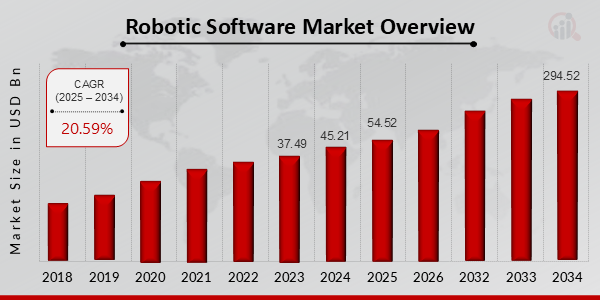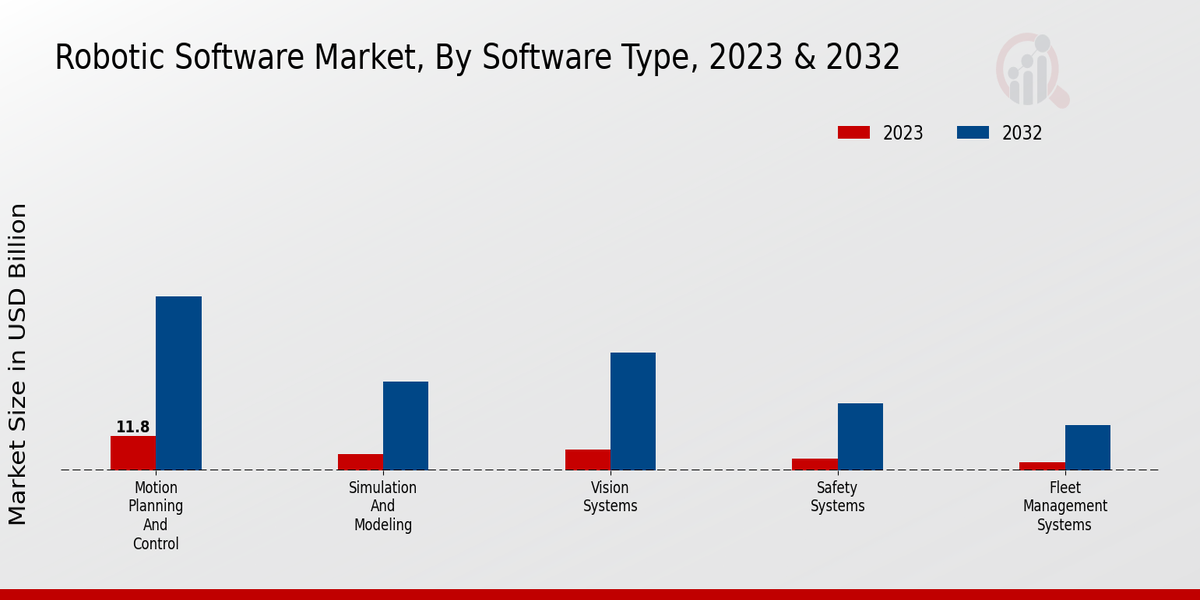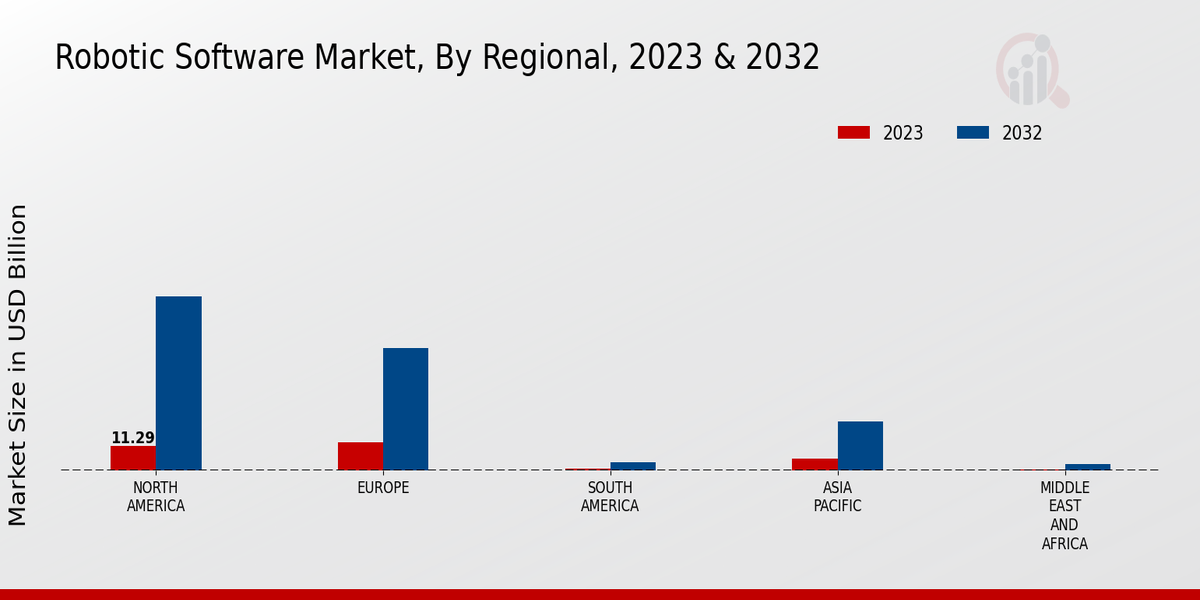Robotic Software Market Overview
Robotic Software Market is projected to grow from USD 54.52 billion in 2025 to USD 294.52 billion by 2034, exhibiting a compound annual growth rate (CAGR) of 20.59% during the forecast period (2025 - 2034). Additionally, the market size for Robotic Software Market was valued at USD 45.21 billion in 2024.
Key Robotic Software Market Trends Highlighted
The global robot software market has a high potential for growth due to the increasing use of robots in different industries. Major drivers of this market are improved efficiency, higher productivity and enhanced safety in manufacturing, health care and others. Moreover, there is a growing demand for collaborative robots and artificial intelligence integration into robotic systems. There are chances of finding and taking possession of these opportunities through advanced software solutions developed for particular industrial applications like self-driving navigation, computer vision, predictive maintenance etc. Besides, the rise of cloud computing and data analytics in robotics provides an avenue for novel software-as-a-service (SaaS) offerings.
Current directions in the robotic software industry include merging AI with robotics, increasing the prevalence of low-code/no-code development platforms, and simulation and modeling being used more often for software testing and validation. All these trends are expected to continue shaping the future landscape of the robotic software market right into the next few years.
Figure1: Robotic Software Market, 2025 - 2034

Source: Primary Research, Secondary Research, MRFR Database and Analyst Review
Robotic Software Market Drivers
Advancements in Artificial Intelligence (AI) and Machine Learning (ML)
The use of robotic software integrating AI and ML technologies has significantly improved the robots’ capabilities. Through AI, robots can learn from data, adapt to new situations and make independent decisions. With the help of ML algorithms, they are able to recognize patterns, detect anomalies and even conduct predictive analytics. As a result, the scope of robot software applications has increased massively, making them more efficient and versatile. The rising use of AI and ML in different sectors, such as manufacturing, healthcare, and logistics, is driving growth in the global robotic software market. Additionally, this integration offers robots an opportunity to do what was not feasible earlier, leading to innovation opportunities and efficiency improvements.
Growing Demand for Automation and Efficiency
The drive behind the Robotic Software Market Industry is the need for automation in various industries. Companies want to optimize their operations and reduce costs while increasing productivity and profits. The Robot software automates repetitive and dangerous tasks while robots are trained to assist and train their human counterparts for more complex, creative solutions. In addition, rapid adoption of robots’ software leads to increased production rates and overall improvements in industrial performance. The need to implement Industry 4.0 standards and take advantage of smart manufacturing practices also increases, which will further stimulate the demand for robotic software that helps to increase competitiveness by implementing cutting-edge technologies.
Expansion of Robot Applications in Diverse Industries
Various industries are able to use and apply robotic software to perform a number of tasks, as well as various applications. The use of robots has been reported in manufacturing, healthcare, logistics, retail sectors, and even in personal services. Such situations arise due to the increasing need for automation, preciseness, and effectiveness among professionals across all areas of the economy. Accordingly, the company developed robotic software with such flexibility that it can deploy robots either in a factory for precision assembly and welding or within a hospital setting where they provide care support or deliver drugs. Thus, there is an emerging market for developers of robotic software since many industries have adopted this technology to meet their specific requirements.
Robotic Software Market Segment Insights
Robotic Software Market Software Type Insights
The robotic software market is segmented by software type into motion planning and control, simulation and modeling, vision systems, safety systems, and fleet management systems. Motion planning and control software enables robots to navigate their environment and perform tasks autonomously. This software is essential for robots that operate in complex and unstructured environments, such as warehouses, factories, and hospitals. The global motion planning and control software market is expected to grow from USD 5.2 billion in 2023 to USD 12.7 billion by 2032, at a CAGR of 11.2%.
Simulation and modeling software allow engineers to create virtual models of robots and their environment. This software is used to test and validate robot designs before they are deployed in the real world. The global simulation and modeling software market is expected to grow from USD 2.4 billion in 2023 to USD 6.5 billion by 2032 at a CAGR of 12.5%. Vision systems software enables robots to "see" their surroundings. This software is used for tasks such as object recognition, navigation, and inspection. The global vision systems software market is expected to grow from USD 3.1 billion in 2023 to USD 8.6 billion by 2032, at a CAGR of 13.1%.
Safety systems software ensures that robots operate safely and do not pose a hazard to humans or property. This software is required by law in many countries and is essential for robots that operate in public spaces. The global safety systems software market is expected to grow from USD 1.8 billion in 2023 to USD 4.9 billion by 2032, at a CAGR of 13.5%. Fleet management systems software helps organizations manage and track their fleets of robots. This software provides real-time data on robot performance, location, and maintenance needs. The global fleet management systems software market is expected to grow from USD 1.2 billion in 2023 to USD 3.3 billion by 2032, at a CAGR of 14.2%. The growth of the robotic software market is being driven by several factors, including the increasing demand for robots in various industries, the need for robots to be more autonomous and intelligent, and the development of new software technologies.
Figure 2: Robotic Software Market, By Platform, 2025 & 2034

Source: Primary Research, Secondary Research, MRFR Database and Analyst Review
Robotic Software Market Application Insights
The Application segment of the Global Robotic Software Market is anticipated to witness substantial growth. Industrial robotics is anticipated to retain the maximum market share as automation solutions are increasingly adopted in manufacturing and logistics. Healthcare Robotics is anticipated to emerge as the fastest growing, as robots are increasingly used in surgeries, rehabilitation, and patient care. Commercial robotics is another segment that is anticipated to witness high growth; these include the robots used in retail, hospitality, and security. Military robotics, used for surveillance, fighting, and logistics, is anticipated to contribute to market growth. Education and Research Robotics, used in educational institutions as well as research laboratories, is another segment. The growth is attributed to the increase in the adoption of robotic software in different industries, the initiatives taken by the governments to promote automation, and the advancement in artificial intelligence and machine learning.
Robotic Software Market Deployment Type Insights
The Global Robotic Software Market is segmented by deployment type into cloud-based, on-premise, and hybrid. Cloud-based robotic software is expected to hold the largest market share in 2023 due to its benefits, such as scalability, flexibility, and cost-effectiveness. The Global Robotic Software Market revenue for cloud-based deployment is projected to reach $12.4 billion by 2024, growing at a CAGR of 22.3%. On-premise robotic software is expected to witness a steady growth rate due to its benefits, such as security and control. Hybrid robotic software combines the benefits of both cloud-based and on-premise deployment types, offering flexibility and customization. The Global Robotic Software Market data shows that the hybrid deployment type is expected to grow at a CAGR of 19.5% during the forecast period. The increasing adoption of robotic software across various industries, such as manufacturing, healthcare, and logistics, is driving the growth of the Global Robotic Software Market.
Robotic Software Market End-User Industry Insights
The End-User Industry segment plays a crucial role in shaping the Global Robotic Software Market. Key end-user industries driving market growth include Automotive: The automotive industry is witnessing a surge in demand for robotic software to automate production processes, enhance vehicle safety, and streamline supply chains. The segment is projected to reach a valuation of $12.5 billion by 2024. Electronics: The electronics industry relies heavily on robotic software for automated assembly, testing, and inspection tasks. This segment is anticipated to grow significantly, reaching $9.3 billion by 2024.Healthcare: Robotic software plays a vital role in healthcare, enabling advancements in surgical precision, patient monitoring, and drug discovery. The healthcare segment is expected to witness substantial growth, reaching $7.8 billion by 2024.
Logistics: The logistics industry is leveraging robotic software to optimize warehouse operations, enhance inventory management, and improve delivery efficiency. This segment is projected to reach $6.5 billion by 2024. Aerospace and Defense: Robotic software is being increasingly adopted in the aerospace and defense industries for tasks such as aircraft assembly, maintenance, and mission planning. The segment is anticipated to grow steadily, reaching $4.2 billion by 2024. These end-user industries present a vast and growing market for robotic software, contributing significantly to the overall Global Robotic Software Market revenue.
Robotic Software Market Regional Insights
Regionally, the market is segmented into North America, Europe, APAC, South America, and MEA. North America held the largest market share in 2023, accounting for 38.2% of the global market, with the US being a major contributor. Europe and APAC are also significant markets, with Europe expected to grow at a CAGR of 19.6% and APAC at 22.3% during the forecast period. South America and MEA are emerging markets with promising growth potential. The growth in these regions is attributed to the increasing adoption of robotics in various industries, government initiatives to promote automation and technological advancements.
Figure 3: Robotic Software Market, By Regional, 2025 & 2034

Source: Primary Research, Secondary Research, MRFR Database and Analyst Review
Robotic Software Market Key Players And Competitive Insights
Major players in the robotic software market are constantly striving to gain a competitive edge by offering innovative products and solutions. Leading Robotic Software Market players are focusing on developing advanced software platforms that can handle complex tasks and enable robots to perform more efficiently. They are also investing in research and development to enhance the capabilities of their software and stay ahead of the competition. The robotic software market's competitive landscape is expected to remain highly competitive in the coming years, with key players continuing to invest in innovation and product development.ABB is a leading Robotic Software Market player that offers a comprehensive suite of software solutions for industrial robots.
The company's software portfolio includes RobotStudio, a powerful simulation and programming tool, and RobotWare, a real-time operating system for robots. ABB's software solutions are designed to help customers improve the efficiency, productivity, and safety of their robotic operations. The company has a strong global presence and serves a wide range of industries, including automotive, aerospace, and electronics.FANUC is another major player in the Robotic Software Market. The company offers a range of software solutions for its industrial robots, including FANUC Robotics, a comprehensive software platform that provides users with a variety of tools for programming, simulation, and monitoring. FANUC's software solutions are designed to help customers improve the performance and reliability of their robots. The company has a strong presence in the automotive industry and also serves a wide range of other industries, including electronics, food and beverage, and medical.
Key Companies in the Robotic Software Market Include
- Mitsubishi Electric Corporation
- ABB
- Emerson Electric Co.
- Rockwell Automation
- Beckhoff Automation GmbH Co. KG
- B Automation
- Phoenix Contact GmbH Co. KG
- Denso Corporation
- Schneider Electric
- Pilz GmbH Co. KG
- Yaskawa Electric Corporation
- Siemens
- Omron Corporation
- KUKA
- FANUC
Robotic Software Market Industry Developments
The Robotic Software Market is projected to reach USD 167.7 billion by 2032, exhibiting a CAGR of 20.59% from 2024 to 2032. Several key factors drive market growth, including the increasing adoption of robotics in various industries, the growing need for automation and efficiency, and the advancements in artificial intelligence and machine learning. Recent news developments include partnerships between leading robotic software providers and industrial automation companies. These collaborations aim to provide comprehensive solutions that integrate robotic software with hardware and infrastructure, offering end-to-end automation capabilities. Additionally, government initiatives and funding for robotics research and development contribute to the market's growth.
Robotic Software Market Segmentation Insights
Robotic Software Market Software Type Outlook
- Motion Planning and Control
- Simulation and Modeling
- Vision Systems
- Safety Systems
- Fleet Management Systems
Robotic Software Market Application Outlook
- Industrial Robotics
- Healthcare Robotics
- Commercial Robotics
- Military Robotics
- Education and Research Robotics
Robotic Software Market Deployment Type Outlook
- Cloud-based
- On-Premise
- Hybrid
Robotic Software Market End-User Industry Outlook
- Automotive
- Electronics
- Healthcare
- Logistics
- Aerospace and Defense
Robotic Software Market Regional Outlook
- North America
- Europe
- South America
- Asia Pacific
- Middle East and Africa
|
Report Attribute/Metric
|
Details
|
|
Market Size 2024
|
45.21 (USD Billion)
|
|
Market Size 2025
|
54.5245.21 (USD Billion)
|
|
Market Size 2034
|
294.52 (USD Billion)
|
|
Compound Annual Growth Rate (CAGR)
|
20.59% (2025 - 2034)
|
|
Report Coverage
|
Revenue Forecast, Competitive Landscape, Growth Factors, and Trends
|
|
Base Year
|
2024
|
|
Market Forecast Period
|
2025 - 2034
|
|
Historical Data
|
2019 - 2023
|
|
Market Forecast Units
|
USD Billion
|
| Key Companies Profiled |
Mitsubishi Electric Corporation, ABB, Emerson Electric Co., Rockwell Automation, Beckhoff Automation GmbH Co. KG, B Automation, Phoenix Contact GmbH Co. KG, Denso Corporation, Schneider Electric, Pilz GmbH Co. KG, Yaskawa Electric Corporation, Siemens, Omron Corporation, KUKA, FANUC |
| Segments Covered |
Software Type, Application, Deployment Type, End-User Industry, Regional |
| Key Market Opportunities |
Advanced Manufacturing Logistics Automation Healthcare Defense and Security Collaborative Robots |
| Key Market Dynamics |
Growing demand for automated and intelligent solutions Advancements in artificial intelligence AI and machine learning ML Increasing adoption in manufacturing healthcare and logistics sectors Government initiatives and funding for robotics research and development Collaboration and partnerships between technology providers and end-users |
| Countries Covered |
North America, Europe, APAC, South America, MEA |
Frequently Asked Questions (FAQ) :
The global robotic software market is expected to witness significant growth in the coming years, with a projected market valuation of 37.49 billion U.S. dollars in 2023. This figure is anticipated to reach 294.52 billion U.S. dollars by 2034, representing a robust compound annual growth rate (CAGR) of 20.59% during the forecast period.
North America region is projected to dominate the global robotic software market throughout the forecast period. This dominance can be attributed to the increasing adoption of robotics and automation solutions in various industries, particularly in countries such as China, Japan, and South Korea.
Robotic software finds applications in a wide range of industries, including manufacturing, healthcare, logistics, and retail. In manufacturing, robotic software is used for tasks such as welding, assembly, and painting. In healthcare, it is employed for surgical assistance, rehabilitation, and drug discovery. In logistics, robotic software is utilized for warehouse management, inventory control, and order fulfillment. In retail, it is used for customer service, inventory management, and shelf-stocking.
The global robotic software market is characterized by the presence of several established players as well as emerging startups. Some of the key competitors in the market include ABB, Siemens, Rockwell Automation, and Fanuc. These companies offer a range of robotic software solutions to meet the diverse needs of customers across various industries.
The growth of the global robotic software market is primarily driven by the increasing adoption of robotics and automation solutions across various industries. This adoption is fueled by factors such as rising labor costs, the need for improved productivity and efficiency, and the growing demand for automation in hazardous and repetitive tasks.
One of the key emerging trends in the global robotic software market is the increasing adoption of cloud-based robotic software solutions. Cloud-based robotic software offers several advantages, such as scalability, flexibility, and reduced infrastructure costs. Additionally, the growing integration of artificial intelligence (AI) and machine learning (ML) technologies into robotic software is expected to further enhance the capabilities and applications of robotic systems.
The global robotic software market faces certain challenges, including the high cost of implementation and maintenance of robotic systems. Additionally, the lack of skilled professionals in the field of robotics and automation can hinder the adoption and effective utilization of robotic software solutions.
The COVID-19 pandemic has had a significant impact on the global robotic software market. The pandemic has led to disruptions in supply chains, production schedules, and business operations worldwide. However, the pandemic has also accelerated the adoption of automation and robotic solutions in various industries as businesses seek to minimize disruptions and maintain productivity.
The global robotic software market presents several potential growth opportunities. The increasing demand for automation solutions in emerging economies, the growing adoption of collaborative robots, and the development of new applications for robotic software are expected to drive growth in the coming years.
Stakeholders in the global robotic software market should focus on developing innovative and cost-effective robotic software solutions that address the evolving needs of customers. Additionally, stakeholders should invest in research and development to enhance the capabilities and applications of robotic software. Partnerships and collaborations between market players can also accelerate the growth and adoption of robotic software solutions.

















